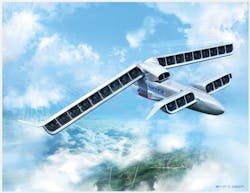Aurora Flight Sciences to develop high-speed DARPA VTOL X-Plane
ARLINGTON, Va. - Officials of the U.S. Defense Advanced Research Projects Agency (DARPA) in Arlington, Va., announced an $89.4 million downselect contract to Aurora Flight Sciences in Manassas, Va., for the second and third phases of the Vertical Take-Off and Landing Experimental Plane (VTOL X-Plane) project.
Aurora Flight Sciences was selected to develop and flight-test the DARPA VTOL X-Plane high-speed VTOL aircraft with the hover capability of a helicopter that can fly nearly 50 percent faster than the Boeing V-22 Osprey tiltrotor aircraft.
The second phase of the DARPA VTOL X-Plane program will involve design, development, and integration; the third phase will involve flight-test demonstrations. Aurora is working with team members Rolls-Royce PLC in Manchester, England, and Honeywell International Inc. in Morris Plains, N.J., on the VTOL X-Plane project. The Aurora team will build a prototype VTOL X-Plane with a distributed hybrid-electric propulsion system based on the Aurora LightningStrike unmanned aircraft.
Aurora's LightningStrike design includes distributed hybrid-electric propulsion ducted fans; a synchronous electric-drive system; tilt-wing- and tilt-canard-based propulsion for vertical takeoff and landing; and high-efficiency hover and fast forward flight. The aircraft design features a Rolls-Royce AE 1107C turbo- shaft engine powering three Honeywell generators, and 24 ducted fans distributed on the wings and canards.
The VTOL X-Plane effort is a four-year, $130 million effort to fly an experimental aircraft with a top sustained flight speed of 300 to 400 knots; hover efficiency of at least 75 percent; cruise efficiency lift-to-drag ratio of at least 10; and useful load capacity of at least 40 percent of the vehicle's projected gross weight of 10,000 to 12,000 pounds.
Aurora Flight Sciences engineers will design a hybrid aircraft that will push VTOL limits in speed, hover efficiency, cruise efficiency, and useful load. Flight tests are scheduled for 2018.
On this contract the Aurora Flight Sciences team will do the work in Manassas, Va.; Indianapolis; Tucson, Ariz.; and Ventura, Calif., and should be finished by September 2018.
FOR MORE INFORMATION contact Aurora Flight Sciences online at www.aurora.aero.

